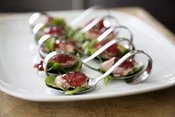Now, apart from the fact that it’s so good, there are a few reasons that braising is such a great way to cook beef.
First of all, it’s really easy. If you have the right cooking gear (a dutch oven works really well), you can make it all in one dish. And once it’s in the oven, you hardly need to worry about it. When dinnertime comes around, you only need to take care of some side dishes. No last minute mad-scramble!
Braising is also a wonderful way to cook tougher meats. Braising beef can turn even the toughest cut of beef into a meal that will melt in your mouth. The tougher cuts are usually a lot less expensive, so it’s a thrifty way to satisfy a beef craving!
So, what is braised beef? Just read on. In this article I’ll start by explaining what braising is. After that, I’ll go through the process of cooking braised beef, step by step:
Here we go!
So What Is Braising?
Braising is a cooking technique where you slow cook a tough cut of meat in just enough liquid to cover the meat half way. The main reason to use this cooking method is to tenderize the meat.

Tougher cuts of beef are full of connective tissues like collagen. It’s these tissues that make the meat so tough. So, if you want to turn your tough beef cut into something a bit more tender, you need to get rid of those tissues. And that’s where braising beef comes in!
You get rid of collagen by melting it. When it melts, collagen turns into gelatin. That makes the beef more tender and moist!
Unfortunately, collagen needs to be very hot for a very long time before it’ll melt… If you just put the beef in the oven to roast, it’ll burn long before the collagen melts.
How does braising help? Well, the key is the liquid. When you start cooking your beef, some of that liquid evaporates. But with a tight lid on the pot, it can’t escape, and so you get an environment full of moisture for your beef to cook in. And when something is moist, it’s much harder to burn!
All that moisture lets you get your beef hotter for longer, so the heat can penetrate deep down into the piece of beef and melt all that tough collagen.
But braising beef isn’t just about tenderizing. It’s also about flavoring! The beef cooks for so long that whatever liquid you use will have plenty of time to infuse the beef with flavor. You can use all sorts of different liquids to give your braised beef a unique, delicious flavor.
Well, that’s what braising is. Now, let’s find out how do it!
Braising Beef – Step By Step
Step 1: Selecting a Cut of Beef
A tough cut of beef is the best choice if you’re planning on making braised beef. The whole point of braising beef is to cook it hot and long enough to melt all the collagen.

A tender piece of meat, like a t-bone steak, doesn’t have any collagen in it. There’s no reason to braise it. Instead, you can grill it, broil it, or use some other dry heat technique to cook it.
So what are the best cuts for braising beef? Try
- Any cut from the chuck, including short ribs. Check the package at the grocery store. The word “chuck” should be on there somewhere.
- Any cut from the shank. These come from the animal’s hard working leg muscles, so they’re full of tough connective tissue. Perfect for braising!
- Cuts from the brisket.
- Certain cuts from the round. Try cuts from the bottom round or the eye of round, or rump roasts.
- Flank steaks can be a bit tough, and are great for braising.
Step 2: Browning the Beef (optional)
Now that you’ve selected a tough cut of beef to braise, we can get started.
The next step is to brown the beef. Why do we want to do this? Well, first of all, a nicely browned piece of meat is a lot more appetizing.
But it’s not just about presentation. When you sear beef, it forms a very flavorful brown crust. This makes it even more delicious, and adds a little something to the meal.
To brown the beef, first pat it dry and dredge it in flour. Shake off any excess flour. A thin coating of flour will help the beef brown more evenly, and will help prevent it from burning or sticking to the pan.
Next, heat a bit of oil in a pan over medium high. Cook each side of your piece of beef until it has a nice brown color. Remove the beef from the pan, pour out the fat, and… you’re done step 2!
Tips
- If you’re planning on braising beef in a pot on the stove, use that same pot to brown your beef. Or, if you have a dish that can go both on the stove and in the oven, you can brown your beef on the stove, then place the dish in the oven. Fewer dishes to do… that’s always a good thing!
- There’s a rumor floating around that searing the beef helps keep the moisture in. That’s not actually true. Luckily you don’t have to worry about that for braised beef! There’s so much moisture in the air in the pot that your beef won’t get dry at all. The real reason you want to sear the meat is for that extra bit of flavor, and how it looks.
Step 3: Aromatic Vegetables and Herbs (optional)
This step is where a lot of the dish’s flavor comes from.
First, chop up some aromatic vegetables. An aromatic vegetable is a vegetable that gives rich flavors and aromas when you cook it. Onions, carrots and celery are three great aromatic vegetables.

Next, select some herbs. Pick whatever you want to flavor your roast with. Rosemary and thyme are some examples, but any herb you like works.
In the same pan you browned the beef, sauté the vegetables and herbs over medium heat for about a minute to release their flavors.
Tips
- Wondering how finely or coarsely to chop up your vegetables? Well, that’s up to you. But here are some guidelines. When you’re done braising the beef, you’ll be left with quite a bit of liquid in your dish. You can use this to make a flavorful sauce. At this point, you can either leave the veggies in there as is, or puree them into the sauce.
- If you want to leave your vegetables as is, chop them finely. It’ll look much better in the sauce than big chunks.
- If you’re going to puree the veggies, you can chop them more coarsely. They’ll be soft enough to puree easily by the time you’re done. Just remember, you sauté the veggies in this step, so they shouldn’t be too big!
- Since braised beef cooks for so long, you could even skip the sautéing step. Just toss some big chunks of veggies in there after adding the liquid. They’ll have plenty of time to add flavor and get soft.
- As I mentioned, this step is optional. The only essential part to braising beef is the liquid (Step 4) and the slow cooking (Step 5). But this step really enhances the flavor of your braised beef. It’s definitely worth chopping up a few veggies, if you have the time.
Step 4: The liquid
Finally, it’s time for the all-important liquid. This is what makes it braised beef.
You have a lot of different options here. Remember, braising beef means cooking the meat in liquid for a long time, so it’s a great opportunity to pick something that’ll add lots of flavor. Some good choices for your liquid are:
First, add a little bit of liquid to the pan where you seared the beef and sautéed the vegetables. Be sure to deglaze the pan – scrape up any brown bits left in the pan and stir them into the sauce. They’re full of flavor!
Next, place the meat back in the pan. Add enough liquid so that it reaches about half way up the beef. Don’t let it cover the beef completely! If you do that, you don’t have braised beef anymore, you have a stew.
Tips
This is a good time to add some extra seasonings to the liquid. Spices like star anise go great with beef, and the long cooking time will really bring out the flavor.
Step 5: Cooking
Now it’s time to cook the beef! Whether you’re braising beef on the stove or in the oven, here are the guidelines you need to follow:
- You need to have a tight lid on your pot or dish. You don’t want any moisture escaping – it’s there to keep your meat from burning, and to allow it to get hot enough to melt the collagen.
- When braising beef, the liquid should be kept at a simmer. If it’s boiling, reduce the heat. For the stove, you can usually leave the burner on low to keep it at a simmer. For the oven, anywhere between 250F and 350F works. Just remember, the lower the temperature, the longer the beef needs to cook.
- To test whether the beef is done, try pulling it apart with a fork. It should fall apart. Of course, the only way to really be sure that the meat is cooked is with a meat thermometer. It should have reached a temperature of about 160F.
Step 6: Making the Sauce
Alright, the beef is cooked and ready. The next step in braising beef is to make a delicious sauce to go along with it.
The first step is to take the beef out of the pot and set is aside. Be sure to cover it so that it stays warm.
Now, we make a sauce from the liquid left in the pot. First, skim any fat from the surface. You can actually just use the liquid as is, but here are some ways to dress it up a little:
- If you want something a bit thicker, you can add a bit of flour or cornstarch to the mix and bring it to a boil, stirring constantly. You can make a roux rather than adding the flour directly to the sauce. It’ll help prevent clumping.
- If you don’t want the chunks of vegetables in there, you can either strain the sauce to remove them, or puree them into the sauce. A hand blender works wonders for that.
- You can also add some seasonings to the sauce. Just taste, and add whatever you feel it needs… salt, pepper, garlic, or anything else you like.
Step 7: Serve and Enjoy!
All that’s left is to serve the meal.
Be sure to let the beef stand 10 to 20 minutes before you carve it. That way, the juices have time to distribute evenly through the meat. You can cover it to keep it warm.
Once it’s had a bit of time to rest, slice the braised beef or cut it into chunks, and serve them with some of the sauce and whatever side dishes you like.
And now that you know all about braising beef… enjoy!










